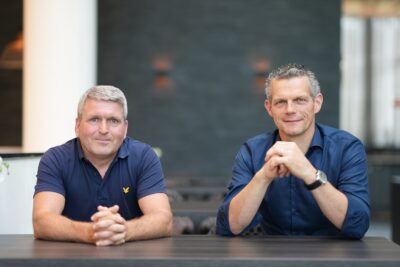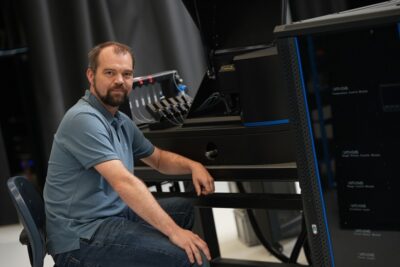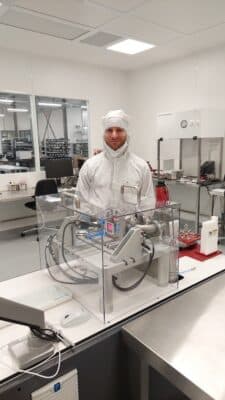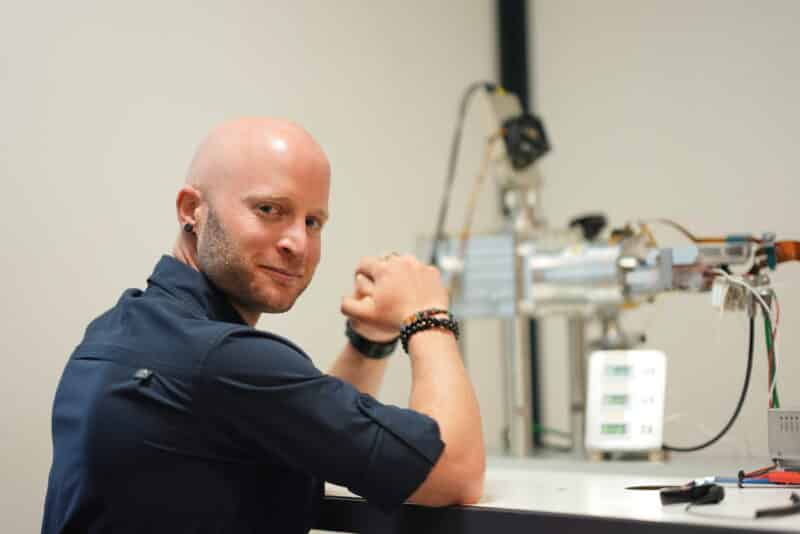When designing a mechatronic system, the actuation often receives the most attention. But the bearing is just as decisive for the accuracy and the system behavior. Hans van de Rijdt and Marc Vermeulen are therefore developing a new training for Mechatronics Academy that is scheduled at High Tech Institute in March 2024: ‘Bearing principles for precision motion’.
There is a wide choice in machine building when it comes to bearings, from sliding, roller and air bearings to hydraulic, elastic and magnetic bearings. Choice stress is therefore lurking. However, that has not prevented bearing technology from becoming somewhat neglected in the high-tech world in recent decades.
Marc Vermeulen, working as a principal mechanical system architect at ASML, does have an explanation for this. “In mechatronics we often talk about the actuated direction, in which you have to achieve a certain accuracy with a drive and a measuring system.”
However, the direction perpendicular to the driven direction is equally important. “Then you’re talking about the degrees of freedom that you don’t actuate. So, you have to constrain these and how do you do that? Because that ultimately determines the accuracy and the entire system behavior to a large extent. The bearings are indeed important for that.”
At least three errors
In his work as an independent consultant in the high-tech industry Hans van de Rijdt regularly encounters that certain bearing principles are overlooked or that pitfalls are not avoided. Together with Vermeulen, he developed the Bearing Solutions training course that will soon start at High Tech Institute. Van de Rijdt: “It happened recently during a review of a large project, on which 140 people worked. Then you would expect that there are enough of them who know something about bearings. Still, I saw at least three errors in the application of bearings.”
It was a design in which the bearing makes a very small angular movement. “That bearing can jam because the lubricant is not distributed properly. That had not been taken into account. Also, an incorrect ball cage had been used, so that the required number of strokes would not be achieved. Bearing suppliers often don’t tell you that sort of thing. If you call, you will get the salesperson who does not know either and it is very difficult to get in touch with the engineer.”

Hans van de Rijdt (left) and Marc Vermeulen (right).
From performance and service life to noise pollution and delivery time
Many factors play a role in the choice of a certain bearing type. In the first place the performance – think of accuracy, speed and acceleration – and the service life, which can be negatively affected by friction and wear. An air bearing scores high on both, but less on costs. For example, an air supply must be integrated into the system design.
Depending on the application, other factors may come into play. A good example is patient welfare. This is the case with CT scanners, for example, where an X-ray tube provided with bearings rotates in a circular gantry around the patient. At Philips, such a scanner was always equipped with a roller bearing, Van de Rijdt recalls, but at a certain point they switched to a large air bearing. “That was for the sake of performance, but above all to reduce noise pollution from the bearing.”
In coarse applications, the choice of bearing can also be crucial. Van de Rijdt talks about a large offshore crane with a ring bearing of 8 meters in diameter. “The lead time for making that large ring bearing was one and a half years, because it was of course not in stock at the factory. That’s why they looked at a sliding bearing as an alternative, which would be much more favorable in terms of lead time. I then made a complete study of it. In the end, that alternative was dropped because the stick-slip behavior of the sliding bearing with such a large diameter had too much of an impact on the operation by the crane driver.”
Ingrained patterns and new competences
In addition to rational substantiation, the choice of bearings often also involves ingrained patterns, says Vermeulen. Placement machines, for example, use roller bearings and not air bearings for cost reasons. Roller bearings, on the other hand, are not used in lithography machines, because lubrication and wear could cause contamination. “Not appropriate in a semicon factory; that’s is a kind of dogma for many manufacturers.” However, the question of whether air bearings can still be replaced with roller bearings for cost reasons comes up regularly.
Van de Rijdt recently was faced with it again. “I could just refer to my report from twelve years ago. For some applications, the performance of ball bearings is sufficient and then their application is more cost-effective. I just tested what people were afraid of. You can neatly control the contamination by ensuring that the bearings are in a downflow under the wafer.”
Things are moving in the meantime, Vermeulen sees at ASML. “All kinds of tests with lubricants and measurements of stiffness and friction are now underway for roller bearings, for example. Of course, we already had the competences for air bearings, magnetic bearings and also elastic bearings (leafspring guides are a popular bearing solution for stages with short strokes, because they are accurate, backlash-free and frictionless, ed.). So now a certain competence is also being built up for roller bearings.”
Avoid overdimensioning
That broad range of competences is important, says Vermeulen. “Leafspring guides have become somewhat self-evident for us. You can make them in one piece, monolithic, with wire EDM. At a certain point you just cannot stop adding complexity and costs. ‘Better safe than sorry’ then becomes the motto, ‘let’s do it this way, then we’ll know for sure it’s right’. But you also have to consider the cost aspect; this is becoming increasingly important.”
Van de Rijdt agrees: “If something has to be nanometer accurate, then monolithic and wire EDM will do the job. As soon as you get out of that range and just talk about micrometers, it doesn’t have to be monolithic. For example, I have designed focus modules for different applications, with exactly the same specification. There was a factor of ten price difference, purely due to the chosen design for the guide.” Vermeulen: “So it starts with the assumptions on which you design a device. The same applies to the bearings. Overdimensioning and preventing that should be a common thread here.” In this way, more attention to bearings can lead to less complexity and costs.
Solutions and applications
The new training will be called Bearing principles for precision motion. That’s a conscious choice, says Hans van de Rijdt. “It’s about solutions for concrete bearing problems, about applications of different types of bearings. We do not dive very deeply into, for example, the tribological aspects, but it’s much more about when you can use which type and what you have to take into account. The best thing is to tell about it from your own experience.”
Insight into how a bearing works will be presented, says Marc Vermeulen. “Many people don’t know, for example, that you can pull an air bearing if you pretension it. So, for example, the fundameltal question of what gives a bearing stiffness will be addressed. But we are indeed not going to discuss the differential equations that describe the motions in a bearing.”
Because that’s usually not where the problem lies in practice, adds Van de Rijdt. “Many people are analytically very strong, but they must have a design to make calculations about. I often notice, not only for bearings but across the entire system scope, that designers and architects have difficulty putting the first lines of a design on paper. If you want to make an initial estimate for a bearing to determine whether it can achieve the required performance and service life, you must first set up a design for it. Going through those iterations is something I want to help people with.”
The training is aimed at designers and architects who regularly have to select a bearing type in their designs. They then have to make a trade-off and optimize the application of the chosen bearing. This is also where control engineering comes into play, for example with magnetic bearings. Think of the ‘flying carpets’ in the ASML machines that have to continuously position a wafer at lightning speed. Vermeulen “They do indeed need to be carefully controlled, but that is not the scope of our training; it is not intended for control engineers.” However, some “basic calculations” will be made to determine the bandwidth and stiffness of the control, adds Van de Rijdt. “We want to provide the designer and the system architect with insight into this.”
Architects Vermeulen and Van de Rijdt form teaching duo
Hans van de Rijdt and Marc Vermeulen both studied Mechanical Engineering in Eindhoven, at the university of applied sciences and university of technology (TUE), respectively. They both did an assignment that suited the Dutch school of design principles for precise movement and positioning. They were colleagues at the illustrious Philips CFT and worked together at ASML on wafer stages, Van de Rijdt on a temporary basis and Vermeulen as an employee. This year, at the request of Mechatronics Academy, they started developing a training on bearing technology together. From next year, they will provide that course, together with ASML employee and TUE part-time professor Hans Vermeulen (indeed, the brother of).
Van de Rijdt worked for Philips CFT for a long time and has now been active for fifteen years as a self-employed professional serving the well-known players in Dutch high-tech, from Philips and ASML to Nexperia. He fulfilled roles as a design engineer, lead design engineer, group leader and department leader. “In the end, I decided that engineering is the most rewarding to do and that the role of system architect suits me.” In 2019, he received the Rien Koster award from DSPE (Dutch Society for Precision Engineering) for his achievements as a developer of multidisciplinary, simple concepts for complex high-tech systems that score well on manufacturability and cost.
Vermeulen obtained his Ph.D. at TUE for the design of a 3D coordinate measuring machine, which was later commercialized by Zeiss. Then he went to Philips CFT. He first wanted to work for different customers and applications before focusing on ASML because of his fascination for the operation of lithography machines. In 2007, he joined the Veldhoven company as an architect for modules of DUV systems. He recently became the mechanical architect for the system that delivers high-pressure tin droplets for the generation of EUV light.
Van de Rijdt gained his first teaching experience 25 years ago, when the prominent companies in the field started with a Mechatronics master class. “I then wrote a booklet for this, Constructeursweetjes (Things a designer needs to know). Things I had experienced in my first ten years of work that you typically didn’t learn in school but were very useful for a designer to know. For example, what you have to take into account concerning with respect to tolerances when milling? Or what you can expect when you start welding a material. So not the design principles, but mainly practical aspects concerning manufacturability. I taught that in the master class and bearings was one of the modules that featured in it.”
Vermeulen also has a long history, at TUE and Philips, of teaching, particularly design principles. “And I have been contributing to the architect training within ASML for a number of years now. As a system architect you have to be a kind of teacher anyway. Involve your people in the making of choices and explain these in such a way that they understand.” As of recently, he also contributes to the trainings Mechatronics System Design and Design Principles for Precision Engineering of Mechatronics Academy. Bearing principles for precision motion is the first one he is developing himself, together with Van de Rijdt. “Our previous collaborations have always been fun; we complement each other well.”
This article is written by Hans van Eerden, freelancer for High-Tech Systems.








